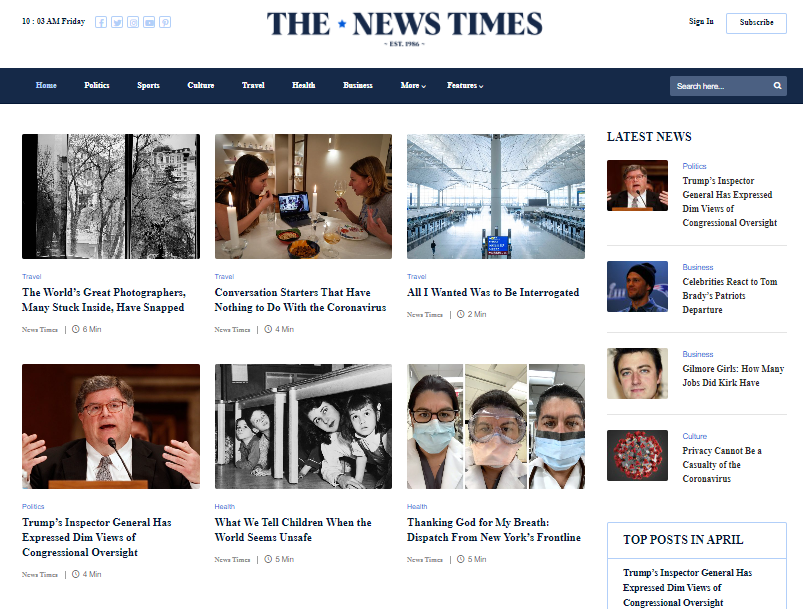The Beginner’s Guide to stnews.live Tools
The Effect of Social Media heading We Take In News Online
Social network has actually essentially changed news consumption. It supplies instant access to details, typically overshadowing conventional media electrical outlets. Nonetheless, this quick dissemination comes with challenges. Individuals encounter the risk of running into misinformation and becoming caught in resemble chambers. The formulas driving personalized material can obscure varied viewpoints. As these characteristics progress, comprehending their ramifications comes to be important for educated involvement in public discussion. What techniques might assist browse this complicated landscape?
The Development of News Intake in the Digital Age
As innovation progressed, the way individuals taken in news transformed substantially in the electronic age (stnews.live). Typical papers and broadcast media started to decrease as the net became a main resource of information. On the internet systems offered immediate access to news short articles, video clips, and podcasts, enabling individuals to stay informed at any kind of time. The convenience of mobile phones further increased this shift, making it possible for customers to receive updates on the move
In addition, the surge of news collectors and web sites facilitated the usage of varied perspectives, equipping customers to customize their news intake based upon personal rate of interests. This advancement additionally motivated wire service to adapt their methods, focusing on digital material and appealing visitors via multimedia layouts. Consequently, the standard obstacles of time and area in news shipment reduced, causing an extra instant and personalized news experience for target markets worldwide.
The Function of Social Media Platforms in News Circulation
Social media site systems have changed news distribution by offering instantaneous accessibility to details. Their algorithm-driven material curation usually focuses on engagement over accuracy, bring about considerable trustworthiness difficulties (stnews.live). As individuals navigate this landscape, the effects for news usage and public discussion become significantly complicated
Instantaneous News Accessibility
Typical news electrical outlets have long been the primary resource of details, the surge of social media platforms has actually considerably changed just how news is accessed and consumed. Instant news access has actually come to be a trademark of the digital age, making it possible for users to receive updates in real time. Systems such as Twitter, Facebook, and Instagram allow news to spread quickly, often going beyond traditional media in rate and reach. Individuals can share stories, remark on occasions, and involve with reporters, creating a vibrant interaction between the audience and news content. This immediacy promotes a culture of urgency, motivating users to inquire swiftly. As a result, the assumption for prompt news has actually improved journalistic techniques, compelling news companies to adjust their techniques to meet the demands of a hectic digital environment.
Algorithm-Driven Web content
While individuals actively engage with material on social media, the algorithms that govern these platforms play a crucial duty in figuring out which news stories acquire exposure. These algorithms evaluate user actions, preferences, and interaction metrics to curate tailored news feeds. Because of this, certain stories might be enhanced while others continue to be unknown, usually focusing on spectacular or trending subjects over substantive reporting. This discerning exposure forms users' assumptions of present events and influences public discussion. Moreover, the dependence on algorithm-driven web content can develop echo chambers, where customers are mostly exposed to perspectives that straighten with their own ideas. The characteristics of news distribution on social media platforms substantially influence how people take in and analyze information in the electronic age.
Integrity Difficulties
As individuals increasingly transform to social media sites for news, the trustworthiness of information encountered on these platforms comes to be a pressing issue. The decentralized nature of social media sites permits any individual to publish material, frequently obscuring the lines in between dependable journalism and false information. Formulas focus on engagement over precision, causing the widespread dissemination of astonishing or misleading stories. This setting postures substantial difficulties for customers attempting to recognize reliable sources. Social media systems, while endeavoring to battle false information via fact-checking and content moderation, run the gauntlet for incongruities and predispositions in their methods. Eventually, the obligation exists with users to critically examine the news they take in, as the rapid spread of info frequently exceeds verification efforts by systems.
The Surge of Resident Journalism and User-Generated Web Content
The surge of resident journalism has actually empowered day-to-day individuals to share news and point of views, frequently giving insights that conventional media may forget. This shift additionally provides significant challenges, especially the spread of misinformation that can occur from unverified content. As user-generated web content ends up being extra widespread, the balance between authentic voices and precision in reporting stays a critical concern.
Equipping Day-to-day Voices

Obstacles of Misinformation
While the surge of person journalism has opened up methods for varied voices in the media landscape, it has actually additionally introduced significant challenges connected to misinformation. The simplicity of visit this page sharing details through social media systems permits people to distribute news swiftly, yet this quick spread frequently comes with the expense of accuracy. User-generated content often lacks the rigorous fact-checking and content oversight that standard journalism site here gives. Consequently, sensationalized or incorrect narratives can obtain traction, misguiding audiences and shaping public understanding (stnews.live). In addition, the blending of point of view and fact within social networks makes complex the difference between qualified details and false information. Therefore, customers should navigate an increasingly complex media atmosphere, needing vital thinking abilities to recognize reputable news sources amidst the sound

Misinformation and Its Effects for Public Discourse
As social media sites platforms significantly dominate the landscape of details dissemination, the proliferation of false information postures significant obstacles for public discussion. Misinformation, often made to deceive or provoke psychological actions, can distort assumptions of fact and threaten count on reputable resources. This phenomenon causes polarized perspectives, as people are attracted towards resemble chambers that enhance their ideas, better lodging departments within society.
The ramifications for public discourse are profound. When residents count on false info, purposeful discussion decreases, and the democratic process endures. Misinformation can incite concern and complication, impacting public health, safety, and political stability. As a result, fostering media proficiency becomes vital, equipping individuals to critically evaluate details and discern reality from fiction. Resolving the difficulties posed by misinformation is crucial for maintaining the integrity of public discourse and ensuring a knowledgeable population with the ability of engaging in useful discussions.
The Impact of Algorithms on News Visibility
Given the central function of formulas in figuring out content presence, their influence on news intake is extensive. These formulas, made use of by social media sites systems, focus on particular kinds of material based upon customer interaction and preferences. As a result, newspaper article that align with preferred trends or audience passions are most likely to be presented prominently, while much less mind-blowing tales might be overlooked. This produces an environment where customers are revealed largely to info that strengthens their viewpoints, possibly causing echo chambers.
The continuous development of algorithms suggests that news companies must adapt their techniques to straighten with these transforming parameters, often focusing on clickbait or mentally billed headings. The integrity of news coverage can be endangered, as important tales might not receive the presence they are worthy of. The algorithmic shaping of news exposure for that reason plays an important role in affecting public understanding and understanding of existing events.
The Shift Toward Aesthetic Storytelling in News Media
Progressively, news media is welcoming visual narration as a powerful device to involve target markets. This strategy leverages images, videos, infographics, and interactive aspects to share details better than standard text-based formats. As focus extends shorten, visuals use a fast, impactful means to communicate complex stories and get hold of viewers' passion.
Platforms like Instagram and TikTok have further accelerated this pattern, engaging wire service to adjust their content strategies to fit these visually-driven settings. By incorporating engaging visuals, news electrical outlets can boost psychological links and foster better understanding of topical concerns.
Additionally, aesthetic narration permits for even more diverse narratives, showcasing several perspectives via dynamic discussions. As audiences increasingly take in news through mobile gadgets, the change toward linked here visuals not only caters to customer preferences yet also aids to damage down barriers to info gain access to. Inevitably, this development shows a broader makeover in how news is produced and consumed in the digital age.
Future Fads: Navigating the Transforming Landscape of News Intake
While the electronic landscape remains to develop, news usage is positioned for significant makeover driven by emerging modern technologies and altering audience behaviors. As expert system and artificial intelligence breakthrough, personalized news feeds will come to be much more common, permitting individuals to obtain content customized to their passions. This modification could lead to higher interaction yet also elevate worries concerning resemble chambers and misinformation.
The rise of voice-activated gadgets and clever audio speakers will affect how news is supplied, shifting the focus from aesthetic to auditory layouts. This pattern may urge wire service to adopt even more succinct and interesting audio material.

Often Asked Inquiries
How Do Social Network Communications Affect News Reputation?
Social media communications can significantly affect assumptions of news trustworthiness. Involvement metrics, such as sort and shares, often shape target market count on, with prominent posts acquiring viewed authenticity, despite the accuracy or dependability of the details provided.
What Function Do Influencers Play in Shaping News Narratives?
Influencers substantially shape news narratives by leveraging their systems to intensify particular tales, usually tailoring content to their audience. This can lead to prejudiced viewpoints, influencing public perception and focusing on sensationalism over factual coverage.
Just How Can Users Identify Reliable News Resources on Social Network?
Individuals can determine reliable news resources on social media by checking the source's credibility, validating truths with several outlets, examining the professionalism of the material, and recognizing prospective predispositions in reporting to assure precise information.
What Impact Does Social Media Carry Conventional Journalism Jobs?
Social media greatly impacts conventional journalism work by altering profits versions, decreasing demand for print media, and cultivating competition from person journalists. Several experts deal with task instability and should adjust to swiftly transforming media landscapes.
How Do Various Demographics Consume News on Social Media?
Different demographics exhibit different choices for news usage on social media sites. More youthful audiences prefer platforms like TikTok and Instagram for fast updates, while older individuals tend to choose Facebook and Twitter for a lot more comprehensive conversations and write-ups.